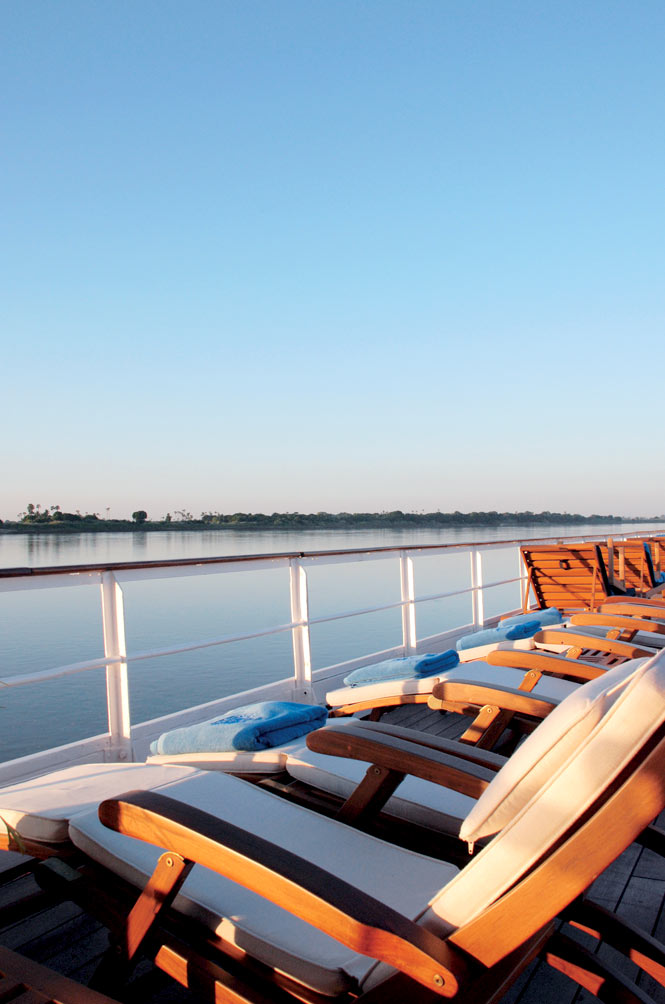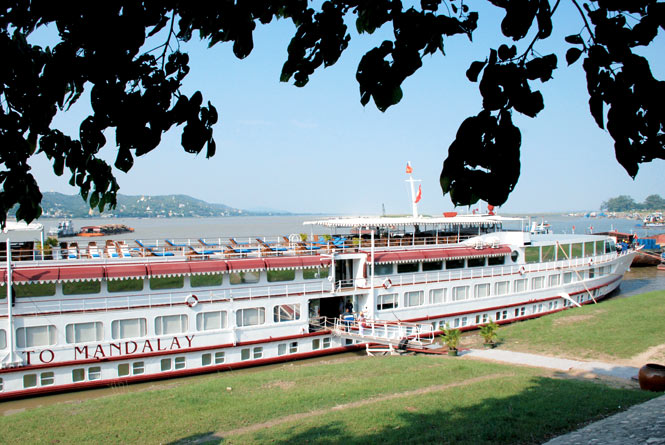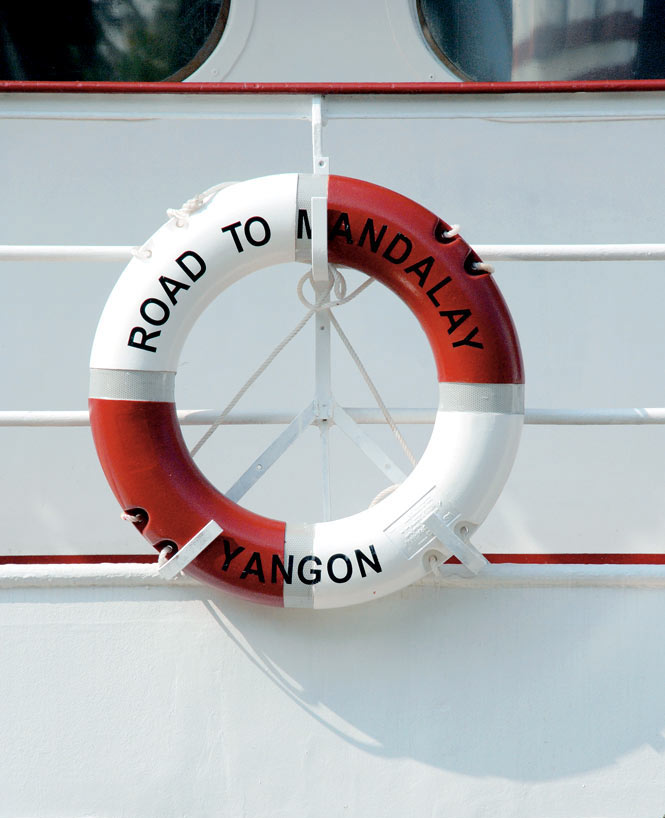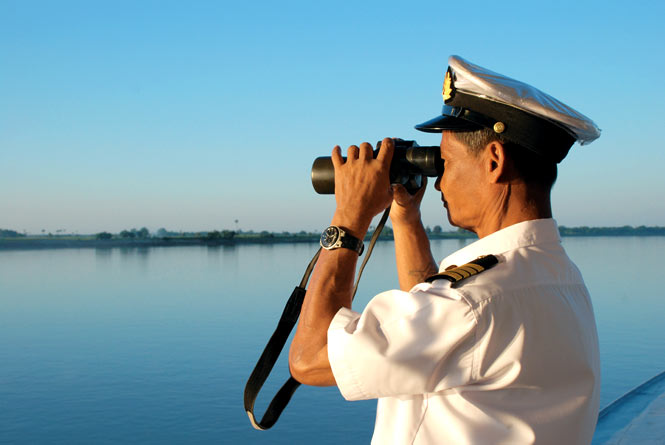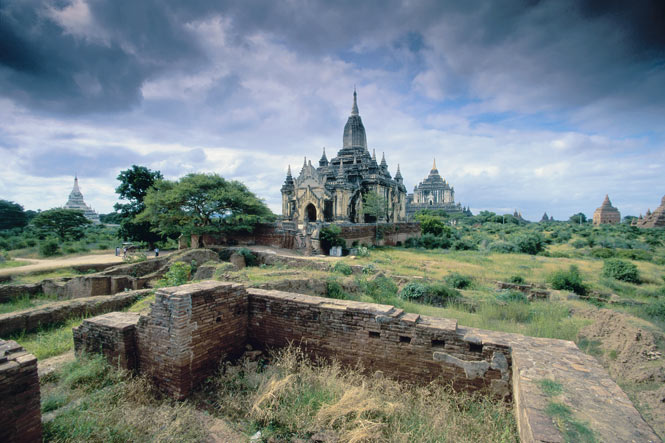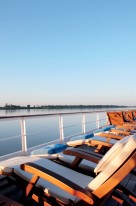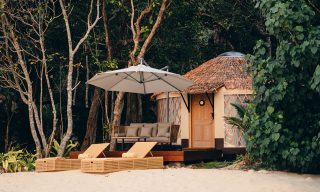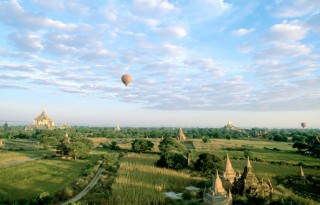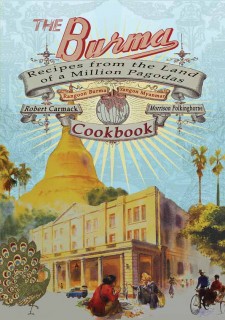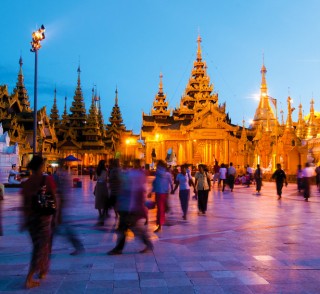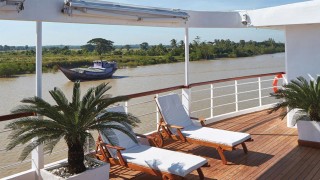Above: Berthed at Shwe Kyet Yet, near Mandalay.
Back in service, Myanmar’s top cruise ship offers a leisurely look at the Irrawaddy River.
Story and photographs by Natasha Dragun
A loud splash breaks the early morning quiet. Those of us up to watch the sunrise from the top deck of the Road to Mandalay rush to the bridge where our captain, Myo Lwin, is scanning the coffee-colored river with his binoculars. It’s our last day aboard the newly refitted vessel, and we’re all hoping to see an Irrawaddy dolphin. Lwin shakes his head. “Probably just a butterfish,” he shrugs. In his three years at the helm, Lwin has spotted only of two of the rare, round-headed cetaceans, which are thought to number fewer than 80 in Burmese waters. “Seeing those dolphins was a highlight,” he tells us. “But don’t hold your breath today.”
The biggest cruiser on the Irrawaddy River, the 100-meter-long Road to Mandalay glides along at a leisurely pace, particularly at this time of day when most passengers are still tucked away in their cabins. Once a pleasure boat on the Rhine, the German-built vessel was purchased by the operators of Orient-Express and ferried to Myanmar in 1995. With the exception of the last 15 months, it has carried tourists between Bagan and Mandalay ever since. The two central Burmese cities are less than 190 kilometers apart, but the shallow-draft Road to Mandalay takes three or four nights to cover the distance, depending on whether it’s traveling upstream or downstream. That’s given me plenty of time to chat with Lwin and his crew about life on the water and the changes seen since Cyclone Nargis struck on May 2, 2008, an event that nearly destroyed their ship.
Myanmar’s longest river, the Irrawaddy begins its course in the shadows of the Himalayas, bisecting the country before dumping its waters into the Andaman Sea some 2,170 kilometers to the south. It’s the lifeblood of this troubled nation, and it can change shape, depth, or course within a matter of hours. When Nargis hit, the river changed within a matter of minutes. Spawned in the Bay of Bengal, the cyclone tore across the country, its 195 kph winds fueling a tidal surge that ravaged the wide Irrawaddy Delta. In Yangon, about 150 kilometers upriver, thousands of boats were destroyed, and the Road to Mandalay, berthed in a canal for off-season maintenance, was pummeled against a rock and almost split in two.
“The ship was so damaged, I was afraid that we could not fix her,” Hla Soe, Lwin’s second-in-command, recalls. French architect Francois Greck was brought in to oversee the Road to Mandalay’s resurrection, alongside a team of Burmese craftsmen. Over the many months that it took to rebuild the ship, none of its crew or staff was laid off. “We employ more than 200 local staff whose livelihood depends on Orient-Express,” Gary Franklin, managing director of the company’s train and cruise operations, tells me. “The majority of them have been with us for more than 10 years … That’s definitely one of the main reasons why we decided to rebuild the ship.” Some were given jobs at other Orient-Express operations in Myanmar, including the Governor’s Residence hotel in Yangon, while others were tasked with helping refit the ship, which was finally refloated with its new look at the end of August.
Rooms are now tastefully fitted with teak, silks, and wall carvings by Burmese artisans, while the spacious en suite bathrooms come with walk-in showers lined with jade tiles. The 47 cabins are set over two floors below a level of bars and restaurants; the teak-planked top deck is our vantage point for dolphin spotting, and also comes with a swimming pool, large cane sofas, and steamer-style deck chairs. “The restoration has been both interesting and challenging,” says Lwin. “Now, we can only look ahead.”
My four-night cruise begins in Bagan, a vast, arid plain dotted with the ruins of more than 2,000 temples and pagodas, described by Marco Polo as “one of the finest sights in the world.” Built from around 850 AD until 1287, when the region was overrun by Mongol invaders, the remarkable monuments cover an area of 42 square kilometers: red-brick, whitewashed, and gilded stupas dotted amid cacti, acacia, and the occasional toddy tree. Our cruise, casting off in late October, coincides with the countrywide Festival of Lights, heralding the end of the rainy season and the retreat of the full moon. As dusk falls, villagers begin decorating their houses and the surrounding pagodas with thousands of candles and lanterns. As the last of the sun disappears, haunting prayers and songs float across the plain to the Road to Mandalay where 27 passengers sit mesmerized on the top deck, silenced by the shimmering scene unfolding before us.

